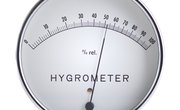
Evaporation occurs when water changes from its liquid form to its vapor form. In this way, water transfers from both the land and water masses to the atmosphere. Approximately 80 percent of evaporation occurs over the oceans, with the balance occurring over inland water bodies, plant surfaces and on land. Both humidity and wind speed affect the rate of evaporation.
Wind Speed
The speed at which air flows over the surface of water affects the rate at which the water evaporates. As the wind blows, it sweeps away airborne water particles that are in the air. The humidity of the air in the region of this evaporation is reduced, which allows more water molecules to dissipate into the air. Wind can also change the vapor pressure by moving air about rapidly, thereby causing it to expand. This process creates room for extra water vapor and evaporation will continue to occur while the wind is blowing.
Relative Humidity
Relative humidity refers to the amount of water in the air, as a fraction of the total amount the air can hold, when it is saturated. Once the air reaches 100 percent relative humidity, it is no longer able to hold water, which then condenses out of the atmosphere. The amount of humidity in the air directly affects the speed at which water will evaporate. Water vapor in the air therefore varies significantly by location.
Partial Pressure
Partial pressure influences the effects of wind speed and relative humidity on evaporation. The partial pressure of water in the air relates to the amount of water that is contained in the air. When a water molecule that returned to water replaces a water molecule that evaporated, evaporation stops, regardless of wind or relative humidity.
Surface Area and Temperature
Temperature and the surface area of the water also influence the effects of wind speed and relative humidity. Water molecules are more exposed to air and more influenced by wind speed and relative humidity, the more a body of water is spread out. Water temperature affects how quickly the water particles move. A water molecule that is moving very quickly is more likely to burst from the water surface into the air. Air, being a gas, expands at higher temperatures. Warm air is therefore capable of holding more water than cold air.
References
About the Author
Virtually growing up in a computer repair shop, Naomi Bolton has held a passion for as long as she can remember. After earning a diploma through a four year course in graphic design from Cibap College, Bolton launched her own photography business. Her work has been featured on Blinklist, Gameramble and many others.
Photo Credits
Jupiterimages/Photos.com/Getty Images
